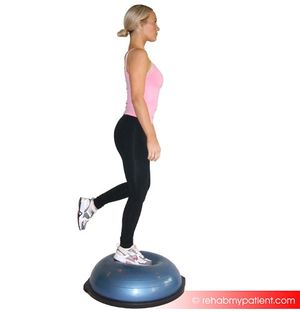Balance Boards
Introduction[edit | edit source]
In physiotherapy a balance or wobble board is used for balance, athletic, postural, coordination and falls prevention training. It is a circular object with an uneven base, on which the user attempts to balance. It is used to prepare people to: avoid injurious falls; to prevent sports injuries especially to the ankle and knee and for rehabilitation.[1] Over the years they have become very popular with many sports training people for eg snow boarders, hockey players, footballers. They are used in physiotherapy departments for various lower limb rehabilitation programs and for balance and fall prevention programs. They also are now being marketed for use at standing desks to keep workers more alert and improve fitness.[2]
Factors affecting degree of difficulty[edit | edit source]
The three variable are
- Surface area of the underside of the board
- The tilt angle ie the angle created when one edge of the board touches the ground.
- The size of the board. The larger the easier.[3]
Uses in Physiotherapy[edit | edit source]
There are many reasons a physiotherapist may choose to use a balance board. The include
Seniors training for falls prevention. A 2011 study found that wobble board training is effective for elderly people to improve their standing balance[4] Studies have also shown that the use of a balance board three times a week can reduce risk of falls in the elderly population.[5]
Lower limb strengthening and rehabilitation following lower limb injuries.
A 2018 study found that a 40 minute session on a balance board could improve the proprioceptive ankle sense and balance ability in those with functionally unstable ankles [8] Another study on female soccer players found that major injuries like ACL tears could not be prevented by balance board training but reduced overall new injury rate[9]
Watch the below video clip showing example balance board based exercises.
Upper Limb strengthening and proprioceptive training
Using a balance board to train your upper extremities can improve balance, stability and proprioceptive awareness. Be sure your client can perform these exercises eg pushups, with good form without a balance board first or they run the risk of injuries to shoulders, elbows or wrists.[10]
Core muscle training
Having a strong stable core is essential for good functional activities and injury prevention. A balance board is a great tool to help with core stabilisation and strengthening.
Make or create
If you don't have access to a balance board you can try using a soft pillow or foam matting.
Another option is to make your own.
References[edit | edit source]
- ↑ Wikipedia. Balance Boards. Available from: https://en.wikipedia.org/wiki/Balance_board (last accessed 29.3.2019)
- ↑ Elisha Van Deusen. Benefits of balance board. Available from: https://www.youtube.com/watch?v=df0XEQZWYRU&feature=youtu.be (last accessed 29.3.2019)
- ↑ Physio supplies. Choosing a balance board. Available from: http://www.physiosupplies.com/blog/ps/171/choosing-a-balance-board/ (last accessed 29.3.2019)
- ↑ Ogaya S, Ikezoe T, Soda N, Ichihashi N. Effects of balance training using wobble boards in the elderly. The Journal of Strength & Conditioning Research. 2011 Sep 1;25(9):2616-22. Available from: https://www.ncbi.nlm.nih.gov/pubmed/21869636/ (last accessed 29.3.2019)
- ↑ Dougherty J, Kancel A, Ramar C, Meacham C, Derrington S. The effects of a multi-axis balance board intervention program in an elderly population. Missouri medicine. 2011 Mar;108(2):128. Available from: https://www.ncbi.nlm.nih.gov/pubmed/21568236 (last accessed 29.3.2019)
- ↑ PT sue. Senior fitness. Available from: https://www.youtube.com/watch?v=LTn0sPOHbxY (last accessed 29.3.2019)
- ↑ PT sue. Senior fitness. Available from: https://www.youtube.com/watch?v=LTn0sPOHbxY (last accessed 29.3.2019)
- ↑ Effects of ankle strengthening exercise program on an unstable supporting surface on proprioception and balance in adults with functional ankle instability Available from: https://www.ncbi.nlm.nih.gov/pmc/articles/PMC5931169/ (last accessed 31.3.2019)
- ↑ Söderman K, Werner S, Pietilä T, Engström B, Alfredson H. Balance board training: prevention of traumatic injuries of the lower extremities in female soccer players?. Knee surgery, sports traumatology, arthroscopy. 2000 Nov 1;8(6):356-63. Available from: https://www.ncbi.nlm.nih.gov/pubmed/11147154/ (last accessed 31.3.2019)
- ↑ Chron. Balance boards for the upper extremities. Available from: https://livehealthy.chron.com/balance-board-exercises-upper-extremities-5384.html (last accessed 31.3.2019)
- ↑ WODfitters video. Balance board core. Available from: https://www.youtube.com/watch?v=NmbV6ZfB-BY (last accessed 31.3.2019)
- ↑ Bob and Brad. How to make a balance board. Available from: https://www.youtube.com/watch?v=a9aNHJPLHHM (last accessed 31.3.2019)







